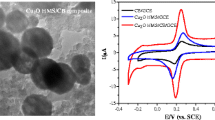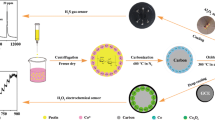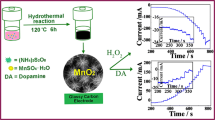Abstract
Hollow molybdenum-dopamine spheres were synthesized and thermally annealed to form hollow Mo2C/C spheres. The morphology, composition and electrochemical behavior of spheres were characterized. A glassy carbon electrode (GCE) was modified with the spheres and then used for simultaneous detection of hydroquinone (HQ), catechol (CC), and resorcinol (RS). Distinct oxidation peaks can be observed for HQ, CC and RS at potentials of −0.004 V, 0.10 V and 0.44 V (vs. SCE). The responses to HQ, CC and RS are linear in the concentration ranges of 0.3~1000 μM, 2~2000 μM and 3~600 μM, respectively. The corresponding detection limits are 0.12, 0.19 and 1.1 μM (at S/N = 3). The sensor was then applied to quantify HQ, CC, and RS in tap water, river water and vegetable juice. Recoveries ranged from 93.5% to 106.5%. The modified GCE is repeatable, reproducible, stable and selective for HQ, CC and RS.

Schematic presentation of a novel electrochemical sensor based on a glassy carbon electrode modified with hollow Mo2C/ carbon spheres for determination of hydroquinone, catechol, and resorcinol.





Similar content being viewed by others
References
Yin H, Zhang Q, Zhou Y, Ma Q, Liu T, Zhu L, Ai S (2011) Electrochemical behavior of catechol, resorcinol and hydroquinone at graphene–chitosan composite film modified glassy carbon electrode and their simultaneous determination in water samples. Electrochim Acta 56(6):2748–2753
Jing Z, Ma J, Zhang Y, Lei H, Wan Q (2014) A hydroquinone sensor based on a new nanocrystals modified electrode. J. Chem. Technol. Biot. 89 (2):259-264
Huang, W., Zhang, T., Hu, X., Wang, Y., & Wang, J. (2018). Amperometric determination of hydroquinone and catechol using a glassy carbon electrode modified with a porous carbon material doped with an iron species. Microchim Acta, 185(1), 37
Li, Z., Yue, Y., Hao, Y., Feng, S., & Zhou, X. (2018). A glassy carbon electrode modified with cerium phosphate nanotubes for the simultaneous determination of hydroquinone, catechol and resorcinol. Microchim Acta, 185(4), 215
Goulart LA, Gonçalves R, Correa AA, Pereira EC, Mascaro LH (2018) Synergic effect of silver nanoparticles and carbon nanotubes on the simultaneous voltammetric determination of hydroquinone, catechol, bisphenol a and phenol. Microchim Acta 185(1):12
Rajkumar C, Thirumalraj B, Chen SM, Veerakumar P, Lin KC (2018) Voltammetric determination of catechol and hydroquinone using nitrogen-doped multiwalled carbon nanotubes modified with nickel nanoparticles. Microchim Acta 185(8):395
Naghian E, Najafi M (2018) Carbon paste electrodes modified with SnO2/CuS, SnO2/SnS and Cu@SnO2/SnS nanocomposites as voltammetric sensors for paracetamol and hydroquinone. Microchim Acta 185(9):406
Chao J, Yong L, Wang ZJ, Yue F, Qi W, Yang R (2016) In situ preparation of hollow Mo2C-C hybrid microspheres as bifunctional electrocatalysts for oxygen reduction and evolution reactions. J Mater Chem A 4(32).
Wan J, Wu J, Xiang G, Li T, Hu Z, Yu H, Liang H, Wan J, Wu J, Xiang G (2017) Structure confined porous Mo2C for efficient hydrogen evolution. Adv Funct Mater 27(45)
Shon JK, Lee HS, Park GO, Yoon J, Park E, Park GS, Kong SS, Jin M, Choi JM, Chang H (2016) Discovery of abnormal lithium-storage sites in molybdenum dioxide electrodes. Nat Commun 7:11049
Liu J, Tang S, Lu Y, Cai G, Chen X (2013) Synthesis of Mo2N Nanolayer coating MoO2 hollow nanostructures as high-performance anode materials for Lithium-ion batteries. Energy Environ Sci 6(9):2691–2697
Wang Y, Yu L, Lou XW (2016) Synthesis of highly uniform molybdenum-Glycerate spheres and their conversion into hierarchical MoS2 hollow Nanospheres for Lithium-ion batteries. Angew Chem 55(26):7423–7426
Minakshi SM, Biswal A, Mitchell D, Jones R, Fernandez C (2016) Correlation among physical and electrochemical behaviour of nanostructured electrolytic manganese dioxide from leach liquor and synthetic for aqueous asymmetric capacitor. Phys Chem Chem Phys 18(6):4711–4720
Lei L, Wang S, Xiao J, Bian X, Zhang Y, Scanlon MD, Hu X, Yi T, Liu B, Girault HH (2013) A nanoporous molybdenum carbide nanowire as an electrocatalyst for hydrogen evolution reaction. Energy Environ Sci 7(1):387–392
Chen WF, Wang CH, Sasaki K, Marinkovic N, Xu W, Muckerman JT, Zhu Y, Adzic RR (2013) Highly active and durable nanostructured molybdenum carbide electrocatalysts for hydrogen production. Energy Environ Sci 6(3):943–951
Liu X, Wu D, Ji W, Hou W (2014) Uniform MoO2@carbon hollow nanospheres with superior lithium-ion storage properties. J Mater Chem A 3(3):968–972
Qiu J, Yang Z, Li Q, Li Y, Wu X, Qi C, Qiao Q (2016) Formation of N-doped molybdenum carbide confined in hierarchical and hollow carbon nitride microspheres with enhanced sodium storage properties. J Mater Chem A 4(34):13296–13306
Wang Y, Yu L, Lou XW (2016) Formation of triple-shelled molybdenum-Polydopamine hollow spheres and their conversion into MoO2/carbon composite hollow spheres for Lithium-ion batteries. Angew Chem Int Ed Eng 55(47):14668–14672
Shen Q, Zhang X, Li Y, Sun T, Wang C, Qin C (2016) Facile synthesis and electrochemical performances of secondary carbon-coated LiFePO4-C composite for Li-ion capacitors based on neutral aqueous electrolytes. J Mater Sci Mater Electron 27(7):7255–7264
Wang C, Sun L, Zhang F, Wang X, Sun Q, Cheng Y, Wang L (2017) Formation of Mo-Polydopamine hollow spheres and their conversions to MoO2/C and Mo2C/C for efficient electrochemical energy storage and catalyst. Small 13(32):1701246
Li X, Du X (2017) Molybdenum disulfide nanosheets supported Au-Pd bimetallic nanoparticles for non-enzymatic electrochemical sensing of hydrogen peroxide and glucose. Sensor. Actuat. B Chem 239:536–543
Wang M, Shi Y, Zhang Y, Yang W, Huang H, Zhang J, Song J (2017) Sensitive electrochemical detection of bisphenol a using molybdenum disulfide/Au Nanorod composites modified glassy carbon electrode. Electroanalysis 29(11):2620–2627
Zeng L, Chen X, Li H, Xiong J, Hu M, Xin L, Li W (2018) Highly dispersed polydopamine-modificated Mo2C/MoO2 nanoparticles as anode electrocatalyst for microbial fuel cells. Electrochim Acta 283:528–537
Lei Z, Xu L, Jiao Y, Du A, Zhang Y, Zhang H (2018) Strong coupling of MoS2 Nanosheets and nitrogen-doped graphene for high-performance Pseudocapacitance Lithium storage. Small 14(25):e1704410
Zhang W, Zheng J, Lin Z, Zhong L, Shi J, Wei C, Zhang H, Hao A, Hu S (2015) Highly sensitive simultaneous electrochemical determination of hydroquinone, catechol and resorcinol based on carbon dot/reduced graphene oxide composite modified electrodes. Anal Methods 7:6089–6094
Zhang H, Bo X, Guo L (2015) Electrochemical preparation of porous graphene and its electrochemical application in the simultaneous determination of hydroquinone, catechol, and resorcinol. Sensor. Actuat. B Chem 220:919–926
Amiri M, Ghaffari S, Bezaatpour A, Marken F (2012) Carbon nanoparticle–chitosan composite electrode with anion, cation, and neutral binding sites: Dihydroxybenzene selectivity. Sensor. Actuat. B 162(1):194–200
Liu L, Ma Z, Zhu X, Zeng R, Tie S, Nan J (2016) Electrochemical behavior and simultaneous determination of catechol, resorcinol, and hydroquinone using thermally reduced carbon nano-fragment modified glassy carbon electrode. Anal Methods 8(3):605–613
Acknowledgements
The project was financially supported by National Natural Science Foundation of China (81773680 and 21575089), free exploration project from the Natural Science Foundation of Shenzhen City (JCYJ20170307150444573) and Scientific Research Foundation for Changjiang Scholars of Shihezi University (CJXZ201501).
Author information
Authors and Affiliations
Corresponding authors
Ethics declarations
The author(s) declare that they have no competing interests
Additional information
Publisher’s note
Springer Nature remains neutral with regard to jurisdictional claims in published maps and institutional affiliations.
Electronic supplementary material
ESM 1
(DOC 6538 kb)
Rights and permissions
About this article
Cite this article
Ren, H., Zhang, Y., Liu, L. et al. Synthesis of hollow Mo2C/carbon spheres, and their application to simultaneous electrochemical detection of hydroquinone, catechol, and resorcinol. Microchim Acta 186, 306 (2019). https://doi.org/10.1007/s00604-019-3432-7
Received:
Accepted:
Published:
DOI: https://doi.org/10.1007/s00604-019-3432-7




